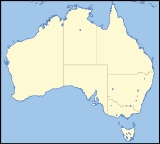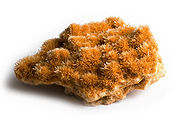
Lake Torrens National Park
Encyclopedia
Lake Torrens National Park is a national park in South Australia
, 345 km north of Adelaide
.
is a 5,700 square kilometre endorheic
saline rift lake in South Australia
,and is located near the bottom of Australia. It forms part of the same rift valley that includes Spencer Gulf
to the south and is approximately 240 km long. It is in the Lake Torrens National Park, and a permit is required to visit. Lake Torrens is usually a dry salt flat. It has been filled with water only once in the past 150 years - in 1989.
as an Important Bird Area
(IBA) because it supported up to 100,000 breeding Banded Stilt
s during the major filling event of 1989. It may occasionally support over 1% of the world population of Red-capped Plover
s. Cinnamon Quail-thrush
es are also common in the IBA.
by Edward John Eyre
in 1839, for the following twenty years it was believed that Lake Torrens was an enormous horseshoe-shaped saltpan encircling the northern Flinders Ranges
and blocking any path to the interior. The first European to penetrate the mythical barrier was A. C. Gregory from the north in March 1858; later the same year, an expedition under B. H. Babbage and Major Warburton in the north-west also crossed the non-existent barrier near modern Marree
. Eyre's horseshoe lake was actually composed of Lake Frome
, Lake Callabonna
, Lake Blanche
, Lake Gregory, Lake Eyre South
, and Lake Torrens itself.

South Australia
South Australia is a state of Australia in the southern central part of the country. It covers some of the most arid parts of the continent; with a total land area of , it is the fourth largest of Australia's six states and two territories.South Australia shares borders with all of the mainland...
, 345 km north of Adelaide
Adelaide
Adelaide is the capital city of South Australia and the fifth-largest city in Australia. Adelaide has an estimated population of more than 1.2 million...
.
Geology
Lake TorrensLake Torrens
Lake Torrens is a salt lake in central South Australia. It is located in the Lake Torrens National Park....
is a 5,700 square kilometre endorheic
Endorheic
An endorheic basin is a closed drainage basin that retains water and allows no outflow to other bodies of water such as rivers or oceans...
saline rift lake in South Australia
South Australia
South Australia is a state of Australia in the southern central part of the country. It covers some of the most arid parts of the continent; with a total land area of , it is the fourth largest of Australia's six states and two territories.South Australia shares borders with all of the mainland...
,and is located near the bottom of Australia. It forms part of the same rift valley that includes Spencer Gulf
Spencer Gulf
The Spencer Gulf is the westernmost of two large inlets on the southern coast of Australia, in the state of South Australia, facing the Great Australian Bight. The Gulf is 322 km long and 129 km wide at its mouth. The western shore of the Gulf is the Eyre Peninsula, while the eastern side is the...
to the south and is approximately 240 km long. It is in the Lake Torrens National Park, and a permit is required to visit. Lake Torrens is usually a dry salt flat. It has been filled with water only once in the past 150 years - in 1989.
Birds
The lake has been identified by BirdLife InternationalBirdLife International
BirdLife International is a global Partnership of conservation organisations that strives to conserve birds, their habitats and global biodiversity, working with people towards sustainability in the use of natural resources...
as an Important Bird Area
Important Bird Area
An Important Bird Area is an area recognized as being globally important habitat for the conservation of bird populations. Currently there are about 10,000 IBAs worldwide. The program was developed and sites are identified by BirdLife International...
(IBA) because it supported up to 100,000 breeding Banded Stilt
Banded Stilt
The Banded Stilt is a nomadic stilt from Australia. It belongs to the monotypical genus Cladorhynchus. It gets its name from the red-brown breast band found on breeding adults, but this is mottled or entirely absent in non-breeding adults and juveniles. Its remaining plumage is pied and the eyes...
s during the major filling event of 1989. It may occasionally support over 1% of the world population of Red-capped Plover
Red-capped Plover
The Red-capped Plover , also known as the Red-capped Dotterel, is a small plover. It breeds in Australia. The species is closely related to the Kentish Plover, Javan Plover and White-fronted Plover.-Description:Red-capped Plovers have white underparts and forehead...
s. Cinnamon Quail-thrush
Cinnamon Quail-thrush
The Cinnamon Quail-thrush is a species of bird in the Cinclosomatidae family.It is endemic to Australia.-References:* BirdLife International 2004. . Downloaded on 25 July 2007....
es are also common in the IBA.
History
DiscoveredEyre's 1839 expeditions
Edward John Eyre's two expeditions of 1839 to the interior of South Australia were his first expeditions as an explorer, if one discounts the two earlier trips he made down the Murray River to Adelaide, herding cattle and then sheep.-North:...
by Edward John Eyre
Edward John Eyre
Edward John Eyre was an English land explorer of the Australian continent, colonial administrator, and a controversial Governor of Jamaica....
in 1839, for the following twenty years it was believed that Lake Torrens was an enormous horseshoe-shaped saltpan encircling the northern Flinders Ranges
Flinders Ranges
Flinders Ranges is the largest mountain range in South Australia, which starts approximately north west of Adelaide. The discontinuous ranges stretch for over from Port Pirie to Lake Callabonna...
and blocking any path to the interior. The first European to penetrate the mythical barrier was A. C. Gregory from the north in March 1858; later the same year, an expedition under B. H. Babbage and Major Warburton in the north-west also crossed the non-existent barrier near modern Marree
Marree, South Australia
Marree is a small town located in the north of South Australia. It lies North of Adelaide at the junction of the Oodnadatta Track and the Birdsville Track, above sea level. The area is the home of the Dieri people. At the 2006 census, Marree had a population of 70.The town was home to Australia's...
. Eyre's horseshoe lake was actually composed of Lake Frome
Lake Frome
Lake Frome is a large endorheic lake in South Australia, east of the Northern Flinders Ranges. It is a large, shallow, unvegetated salt pan, 100 km long and 40 km wide, lying mostly below sea level and having a total surface area of 259,615 hectares...
, Lake Callabonna
Lake Callabonna
Lake Callabonna is a dry salt lake with little to no vegetation in northeastern South Australia, approximately southwest of the junction of South Australia, Queensland and New South Wales at Cameron Corner. It is an important site for late Pleistocene fossils...
, Lake Blanche
Lake Blanche
Lake Blanche is a salt lake in central South Australia. It lies below sea level. It forms part of the Strzelecki Desert Lakes Important Bird Area, identified as such by BirdLife International because of its importance for waterbirds when holding water in the aftermath of floods....
, Lake Gregory, Lake Eyre South
Lake Eyre
Lake Eyre is the lowest point in Australia, at approximately below sea level, and, on the rare occasions that it fills, it is the largest lake in Australia and 18th largest in the world...
, and Lake Torrens itself.


